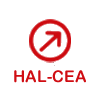Joint EURADOS-EANM initiative for an advanced computational framework for the assessment of external dose rates from nuclear medicine patients
Résumé
Abstract Background In order to ensure adequate radiation protection of critical groups such as staff, caregivers and the general public coming into proximity of nuclear medicine (NM) patients, it is necessary to consider the impact of the radiation emitted by the patients during their stay at the hospital or after leaving the hospital. Current risk assessments are based on ambient dose rate measurements in a single position at a specified distance from the patient and carried out at several time points after administration of the radiopharmaceutical to estimate the whole-body retention. The limitations of such an approach are addressed in this study by developing and validating a more advanced computational dosimetry approach using Monte Carlo (MC) simulations in combination with flexible and realistic computational phantoms and time activity distribution curves from reference biokinetic models. Results Measurements of the ambient dose rate equivalent Ḣ * (10) at 1 m from the NM patient have been successfully compared against MC simulations with 5 different codes using the ICRP adult reference computational voxel phantoms, for typical clinical procedures with 99m Tc-HDP/MDP, 18 FDG and Na 131 I. All measurement data fall in the 95% confidence intervals, determined for the average simulated results. Moreover, the different MC codes (MCNP-X, PHITS, GATE, GEANT4, TRIPOLI-4 ® ) have been compared for a more realistic scenario where the effective dose rate Ė of an exposed individual was determined in positions facing and aside the patient model at 30 cm, 50 cm and 100 cm. The variation between codes was lower than 8% for all the radiopharmaceuticals at 1 m, and varied from 5 to 16% for the face-to face and side-by-side configuration at 30 cm and 50 cm. A sensitivity study on the influence of patient model morphology demonstrated that the relative standard deviation of Ḣ * (10) at 1 m for the range of included patient models remained under 16% for time points up to 120 min post administration. Conclusions The validated computational approach will be further used for the evaluation of effective dose rates per unit administered activity for a variety of close-contact configurations and a range of radiopharmaceuticals as part of risk assessment studies. Together with the choice of appropriate dose constraints this would facilitate the setting of release criteria and patient restrictions.
Origine : Publication financée par une institution
licence : CC BY - Paternité
licence : CC BY - Paternité




